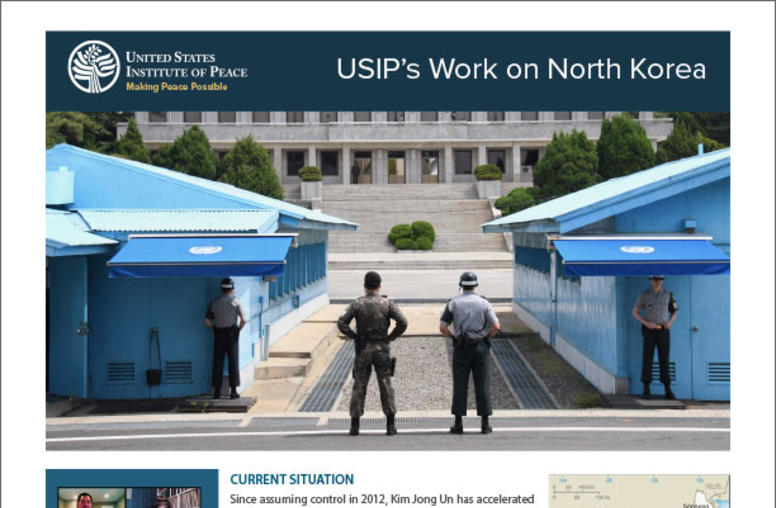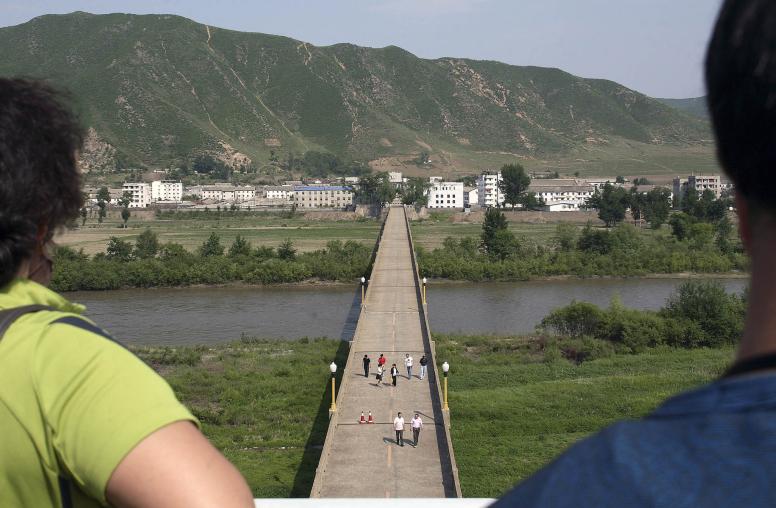Panmunjom: Will the Pageantry Lead to Peace with Pyongyang?
USIP’s Frank Aum says the inter-Korean summit will raise expectations for the proposed Trump-Kim meeting
At a historic inter-Korean summit Friday, North and South Korean leaders pledged to work to remove all nuclear weapons from the Korean Peninsula and declare an end to the Korean War within a year. While 2017 saw significant progress in North Korea’s nuclear and missile programs leading to fears of military action, the inter-Korean summit could potentially lay the groundwork for peace. The summit was laden with symbolic gestures, with Kim Jong Un’s walk across the border marking the first time a North Korean leader visited South Korea. What remains to be seen is whether the agreements emerging from the summit will actually be implemented, unlike past efforts. USIP Senior Expert on North Korea Frank Aum examines the long-term potential for peace following the summit.

North and South Korean leaders have met in the past (2000 and 2007) to discuss improving relations. What is potentially different about this summit? What are the risks and gains for both sides?
Although this is the third inter-Korean summit in history, this is the first inter-Korean summit with the young North Korean leader Kim Jong Un, who had been perceived, at least until recently, as avoiding meetings with foreign counterparts. This is also the first time that a North Korean leader has entered South Korean territory (the first two summits were in Pyongyang), although the meeting was only a few hundred feet on the South Korean side of the Demilitarized Zone (DMZ). Despite all the pageantry and big smiles between the two Korean leaders, there wasn’t that much of substance that was new or revelatory.
The two Koreas have made joint declarations in the past—including in 1972, 1991, 2000, and 2007—that expressed hopes for an end to military hostility and better relations between the two countries, and none of them led to the end of the Korean War or significantly better relations between Seoul and Pyongyang. This declaration doesn’t appear to be any different. Diplomatic engagement with North Korea should be viewed as a long-term process; it’s like a 20-course meal and the inter-Korean summit was like a safe, crowd-pleasing appetizer.
On the other hand, Kim Jong Un is not Kim Il Sung or Kim Jong Il. South Korean President Moon Jae-in is not President Kim Dae-jung or President Roh Moo-hyun. And President Trump is like no other U.S. president in history.
There has been significant focus on the optics of the inter-Korean summit. On the substance side, what, if any, long-term effects will it have? Will the agreements actually be implemented?
The two Koreas agreed on many steps to improve inter-Korean ties, reduce military tension and the danger of war, and realize the goal of peace and denuclearization on the Korean Peninsula. The commitment to improve inter-Korean cooperation and exchanges—such as establishing a joint liaison office in Kaesong, jointly participating in international sporting events like the 2018 Asian Games, proceeding with separated family reunions on August 15 (National Liberation Day), and collaborating on improving railways and road—are all doable.
As expected, two Koreas - amid pageantry - make joint declaration (like '91, '00, '07) that aspires to denuclearization and peace, and commits to stronger inter-Korean ties. Not much new substance. But KJU, Moon, and Trump are different from past leaders. #InterKoreanSummit https://t.co/S47Vm9Sj41
— Frank Aum (@frankaum1) April 27, 2018
The efforts to end military hostilities will be more difficult. Convening frequent military talks, the first one to be held in May, is a realistic start, but declarations about transforming the DMZ into a peace zone or turning the area around the Northern Limit Line in the West Sea into a maritime peace zone sound more daunting. And of course, the pledges to pursue an end to the Korean War and a transition from armistice into a peace treaty by the end of the year, as well as the broader goal of denuclearizing the Korean Peninsula, are ambitious goals. The biggest questions remain: Will North Korea denuclearize completely and verifiably? And if so, what will the United States have to concede to make this happen?
North Korea has agreed to work with South Korea toward the complete denuclearization of the Korean Peninsula. What are Washington and Pyongyang prepared to give up and what will they likely ask for in return?
The United States will demand the complete, verifiable, and irreversible denuclearization of the Korean Peninsula, and all of this to happen fairly quickly. President Trump has repeatedly said that he will not repeat past mistakes, which means accepting a prolonged, phased negotiation process where North Korea can extract concessions and buy time. North Korea has already conceded an end to nuclear and intercontinental ballistic missile testing, closing the Punggye-ri nuclear test site, and halting all nuclear technology transfers, but these aren’t new concessions and they are all reversible.
The more difficult step is to achieve a hard freeze on all nuclear and missile programs, including plutonium reprocessing, uranium enrichment, and short-, medium-, intermediate-range, static, and submarine-based missile testing. And then the real difficult task is verifying North Korea’s actions with certainty—there may simply need to be an accepted level of ambiguity in verification.
For its part, Pyongyang is demanding an end to nuclear and strategic assets on the Korean Peninsula, no more nuclear and strategic assets being used in joint U.S.-South Korean military exercises, a guarantee against a U.S. attack, and a peace treaty. The United States should be able to work with this, unless North Korea is playing games. For example, if by requesting an end to nuclear and strategic assets on the Korean Peninsula, North Korea is also demanding an end to the extended deterrence commitment that the United States provides to South Korea, that would be a non-starter.
Washington needs to think hard about what it is willing to concede. If it thinks that North Korea will be satisfied with sports and cultural exchanges or humanitarian assistance, then it would be very naïve. Washington should hold off on easing sanctions, but it needs to consider significant carrots, such as eliminating nuclear and strategic assets from the Peninsula and military exercises, and at least starting the process of a peace treaty.
During the Xi-Kim summit, North Korea reportedly talked about “progressive and synchronous” measures that the United States and South Korea must take, which sounds like a phased, incremental process. So, all sides will need to come to some sort of compromise on the timeline of negotiations to manage expectations.
How will the inter-Korean summit affect the proposed meeting Trump-Kim meeting? Will Washington be bound by the agreements made at the summit?
Behind the scenes, there have already been several U.S.-North Korea planning meetings, including one between Kim Jong Un and then CIA Director Mike Pompeo, as well as U.S.-South Korea coordination meetings about the two summits. But, it is unclear if the inter-Korean summit will have a significant additional effect on the Trump-Kim meeting from a substantive standpoint. However, the success of the inter-Korean summit from an optics standpoint and the aspirational joint statement language about achieving denuclearization and peace certainly increase public expectations and the perception of momentum going into the Trump-Kim meeting.
President Trump’s own tweet (“KOREAN WAR TO END”) also increases pressure on himself to deliver a grand outcome. Conversely, Kim Jong Un seemed to want to temper expectations, saying, “As the expectations are high, so is the skepticism. In the past, we had reached big agreements, but they were not implemented for more than 10 years. There are people who are skeptical that the results of today’s meeting will be properly implemented.”
This being said, I didn’t see anything from the inter-Korean summit that would bind or limit the decision space of President Trump. President Moon recognizes that any significant agreements on denuclearization or a peace regime must be agreed to by Washington and Pyongyang.



